






Maristella Casciato considers the story behind Chandigarh, the futurist Indian city created by Swiss-French modernist architect, Le Corbusier
On 19 December 1950, the Swiss-French planner Le Corbusier signed a contract with the Indian government to act as architectural advisor on the master plan for Chandigarh. It would be a long endeavour: more than thirteen years would pass before the Legislative Assembly building was inaugurated on 15 April 1964, and the government of Punjab received its institutional seat. As a capital built from scratch, Chandigarh was to compensate this region in northwestern India for the loss of Lahore during Partition. It would also show that modern architecture, on its new postwar path, could still embrace a political ideal in order to construct the social and cultural identity of a city and its future residents.
Le Corbusier and Indian prime minister Jawaharlal Nehru, the central figures of this enterprise, were enacting a modern version of a patronage relationship between the architect and the enlightened prince. Both were aware not only of the project’s historical and political significance but also of its looming programmatic difficulties. The Cold War was well under way, and our two principal actors had only partly similar aims. While both were motivated by deep idealism and linked by their humanitarian socialism, this common ground should not to be confused with a shared political creed. Nevertheless, for more than a decade the two men invested a great deal of energy in advancing the Chandigarh project, using the full weight of their institutional and intellectual charisma while balancing their respective goals.
Even before landing in India, Le Corbusier conveyed not only a total confidence that he could undertake the project successfully but also an almost boyish enthusiasm for the adventure. It was a moment of apotheosis for the architect, who seemed transformed, immediately appropriating the place as his own in a letter to his wife Yvonne: ‘Chandigarh (this is the name of our new capital) . . . . We are on the site of our city, beneath a marvellous sky in the midst of a timeless landscape. . . . All is calm, slow, harmonious, lovely. . .’ (25 February 1951; italics added).
The Indian adventure had barely begun. As he had pledged to Nehru, Le Corbusier would remain committed to his task even under adverse conditions. The architect made twenty-three trips to Chandigarh in fourteen years; the final visit took place in April 1964 for the inauguration of the Legislative Assembly building, at which Nehru was also present. Both men had kept their appointment with history and with architecture.
Extracted from the foreword by Maristella Casciato in Chandigarh Revealed: Le Corbusier’s City Today by Shaun Fynn (Princeton Architectural Press, out 4 April 2017, £45)
For more info on the book, click here.
Photography Shaun Fynn